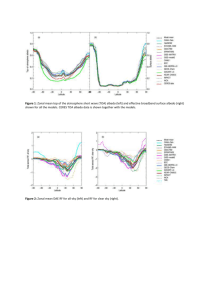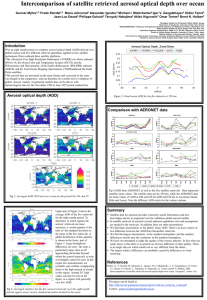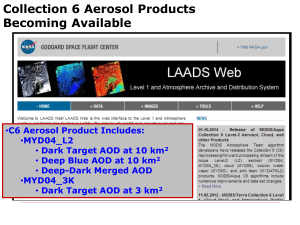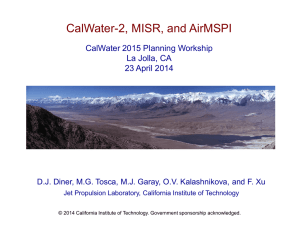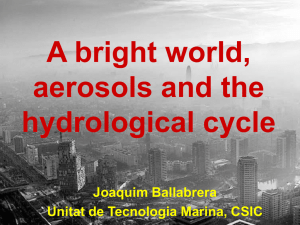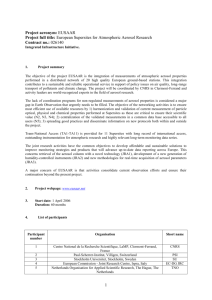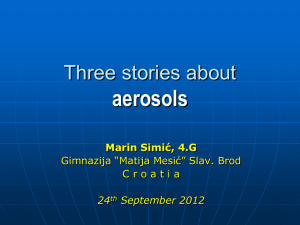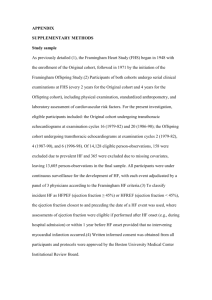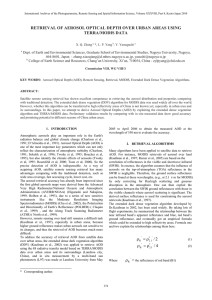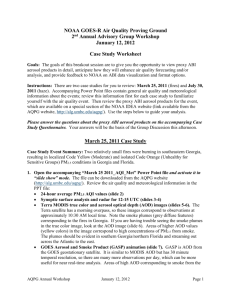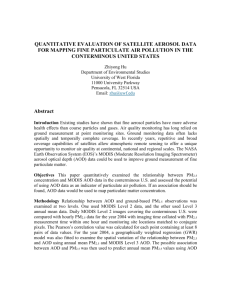AEROCOM-AC&C hindcast experiments
advertisement
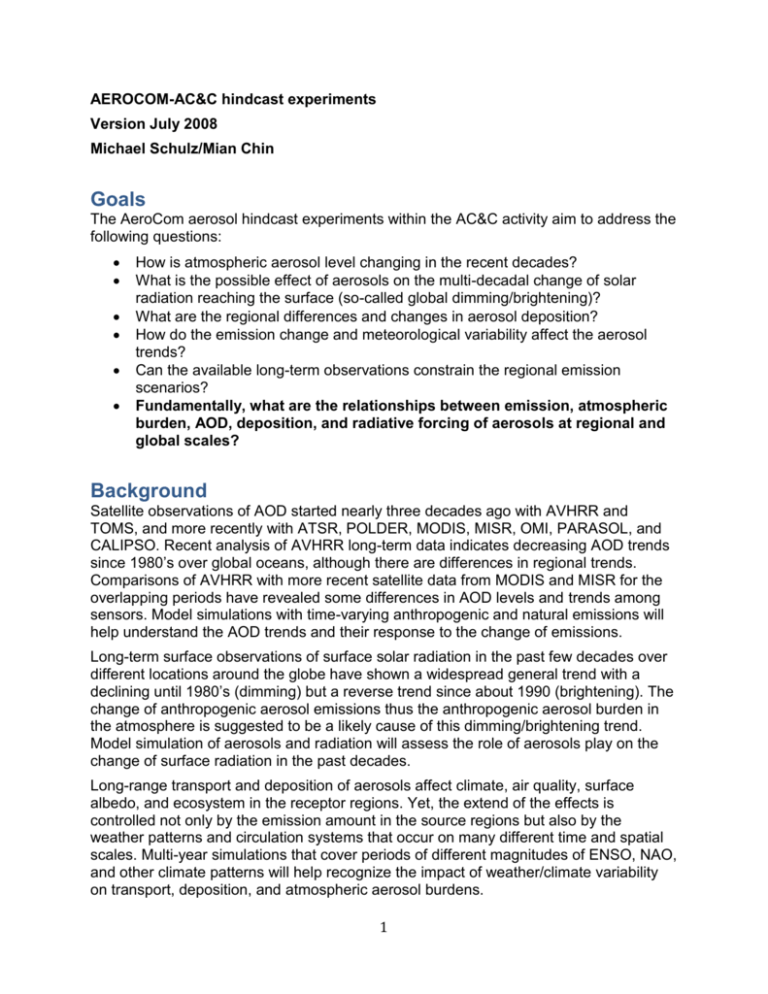
AEROCOM-AC&C hindcast experiments Version July 2008 Michael Schulz/Mian Chin Goals The AeroCom aerosol hindcast experiments within the AC&C activity aim to address the following questions: How is atmospheric aerosol level changing in the recent decades? What is the possible effect of aerosols on the multi-decadal change of solar radiation reaching the surface (so-called global dimming/brightening)? What are the regional differences and changes in aerosol deposition? How do the emission change and meteorological variability affect the aerosol trends? Can the available long-term observations constrain the regional emission scenarios? Fundamentally, what are the relationships between emission, atmospheric burden, AOD, deposition, and radiative forcing of aerosols at regional and global scales? Background Satellite observations of AOD started nearly three decades ago with AVHRR and TOMS, and more recently with ATSR, POLDER, MODIS, MISR, OMI, PARASOL, and CALIPSO. Recent analysis of AVHRR long-term data indicates decreasing AOD trends since 1980’s over global oceans, although there are differences in regional trends. Comparisons of AVHRR with more recent satellite data from MODIS and MISR for the overlapping periods have revealed some differences in AOD levels and trends among sensors. Model simulations with time-varying anthropogenic and natural emissions will help understand the AOD trends and their response to the change of emissions. Long-term surface observations of surface solar radiation in the past few decades over different locations around the globe have shown a widespread general trend with a declining until 1980’s (dimming) but a reverse trend since about 1990 (brightening). The change of anthropogenic aerosol emissions thus the anthropogenic aerosol burden in the atmosphere is suggested to be a likely cause of this dimming/brightening trend. Model simulation of aerosols and radiation will assess the role of aerosols play on the change of surface radiation in the past decades. Long-range transport and deposition of aerosols affect climate, air quality, surface albedo, and ecosystem in the receptor regions. Yet, the extend of the effects is controlled not only by the emission amount in the source regions but also by the weather patterns and circulation systems that occur on many different time and spatial scales. Multi-year simulations that cover periods of different magnitudes of ENSO, NAO, and other climate patterns will help recognize the impact of weather/climate variability on transport, deposition, and atmospheric aerosol burdens. 1 Approach Model runs: Table 1 below summarizes the model hindcast aerosol (HCA) runs: Table 1. Model hindcast runs RUN Purpose Set-up Options Notes HCA-0 Aerosol trends, variability, spatial distributions, relationships between emission, mass, AOD, forcing that change with time - Time-varying anthropogenic and natural emissions with participants’ choice HCAIPCC Same as HCA-0 - Same as HCA-0 but using IPCC emissions (available October 2008) Using dust and sea-salt emissions as provided by selected model(s) Expected to be run by most/all model groups HCA-FX Influence of weather/climate variability on transport and deposition of anthropogenic aerosols Same as HCA-0 but using 2001 anthropogenic emissions (including biomass burning) for the entire simulation period Same as above Natural emissions are the same as in HCA-0 or HCAIPCC HCA-MET Aerosol interaction with cloud and meteorology GCMs with fully coupled aerosolmeteorology with prescribed SSTs Expected to be run by a few model groups early on (before October 2008) - Using reanalyzed or nudged meteorology The GCMs only forced by SSTs, not nudged meteorology Time period options: Option 1 (satellite era): 1980 – 2009 (30 continuous years) Option 2 (EOS and A-Train era): 2000 – 2009 (10 continuous years) Option 3 (HTAP SR1/SR6 and CALIPSO comparison): 2001 and 2007 only In addition, models choosing option 1 and 2 are encouraged to add a one-year simulation (with appropriate spin-up) for preindustrial conditions of aerosol emissions corresponding to the year 1860. This is to assess the change of aerosol loading and forcing since the preindustrial period. Observations: There is a suite of observations from satellite, ground-based networks, and field measurements available during the model simulated time period. Table 2 lists some of the key datasets that will be used to compare with the model results: 2 Table 2. Observation data Platform Sensor/program Time period Quantity measured/retrieved Satellite AVHRR, NOAA AVHRR, GISS TOMS POLDER-1, -2, PARASOL ATSR-2, AATSR MODIS MISR MSG-SEVIRI OMI CALIOP 1981 – present AOD (over ocean only) 1979 – 2001 1997 – present (?) AOD, absorbing aerosol index Fine-mode AOD, non-spherical fraction 1995 – present 2000 – present 2000 – present 2004 - present 2004 – present 2006 – present AERONET 1990s – present GEBA BSRN EARLINET MPLNET ADNET IMPROVE EMEP Univ. Miami INDOEX 1960s – present 1992 – present 2000 – present 2000 – present ???? 1985 – present 1980s – present 1980s – 1990s January – April 1998 and 1999 February – May 2001 AOD, effective radius AOD, fine-mode fraction AOD, non-spherical fraction AOD, effective radius (geostationary) AOD, absorbing aerosol AOD Vertical profiles of attenuated backscatter and extinction AOD, fine-mode AOD, single scattering albedo, size distribution Surface solar radiation Ground-based network Aircraft measurements ACE-Asia/TRACEP ICARTT INTEX-B/ MILARGRO (N-)AMMA POLARCAT/ ARCTAS EUCAARI/EMEP Aerosol profile (Lidar) Aerosol composition and concentration Aerosol concentrations, vertical profile, scattering, absorption, size Summer 2004 Spring 2006 Summer 2006 Spring and Summer 2008 May 2008 Emissions Different authors have recently contributed to a collection of emissions on the AeroCom data server in order to facilitate the simulations. The different emission data sets are under inspection by the AeroCom working group on emissions. A release of at least one complete emission data set (including anthropogenic, biomass burning, and volcanic aerosols and precursors) is planned for early summer 2008. Interested scientists are suggested to contact Thomas Diehl and Stefan Kinne directly for details. An account for getting access to the AeroCom data server can be obtained from Michael Schulz. Once the AC&C and IPCC emission scenarios are available they will be suggested as standard anthropogenic emission data set. 3 Time frame The HCA-0 runs from a few models are expected to be done in summer 2008, before September 15. Initial evaluation will be presented at the AeroCom workshop on 8-10 October 2008. The IPCC historical anthropogenic emission datasets are expected to be released in October 2008 and will be distributed to AeroCom model groups. Model output diagnostics See AeroCom standard diagnostics excel file for further explanations 4
